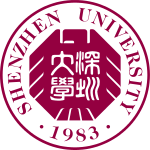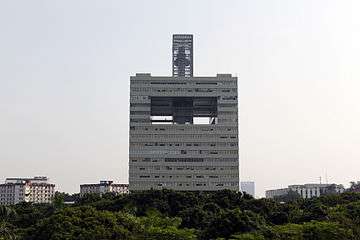Shenzhen University
| 深圳大学 | |
 | |
| Motto |
自立,自律,自强 脚踏实地,自强不息 |
|---|---|
Motto in English |
Independent, Self-discipline, Self-improvement Be down-to-earth and constantly strive for self-perfection |
| Type | Public university |
| Established | 1983 |
| President | Qingquan LI |
Academic staff | 2,100 |
| Location | Shenzhen, Guangdong Province, China |
| Campus | 2.90 km2 (1.12 sq mi) |
| Nickname | SZU |
| Website |
www |
| Shenzhen University | |||||||||||
| Simplified Chinese | 深圳大学 | ||||||||||
|---|---|---|---|---|---|---|---|---|---|---|---|
| Traditional Chinese | 深圳大學 | ||||||||||
| |||||||||||
Shenzhen University (SZU, Chinese: 深圳大学) is a public university established in 1983 located in Nanshan district, Shenzhen, Guangdong, China. It is accredited by the State Council of the People's Republic of China and is funded by the Shenzhen Council Government. The university took its first enrollment the same year at what Deng Xiaoping called "Shenzhen Speed".[1] Deng also was named the "father of Shenzhen University." It is regarded as the fastest developing university in China, and also is the Top 100 Universities in China. Its most famous alumni is Ma Huateng, the founder and CEO of Tencent Company. Chinese media noted that Shenzhen University is the "Chinese Stanford University".[2]
Today's Shenzhen University is already a multi-disciplinary comprehensive university. It is trying hard to expand its international presence, and the idea of liberal education helps it maintain the leading position as one of the top universities in modern China. The medical, computer, architectural design and engineering programs at Shenzhen University play leading roles in Asia. Based on such fast growth rates, it has become one of the top universities in China, even East Asia, its quality of teaching and learning enjoys even higher prestige.
Location
SZU comprises two campuses, Houhai campus and Xili campus, occupying 2.8 square kilometers in total. The Houhai campus is located on the picturesque coastline of Houhai Bay with 1.44 square kilometers, spreading across rolling hills covered with lichee trees and flowers, two lakes, a forest, an abundance of green space and works of art. The new Xili campus now under construction is located in the city’s University Town and takes up nearly 1.4 square kilometers.
History
Shenzhen University was established as a full-time comprehensive university, in line with the aim of China's Ministry of Education (MOE) to further develop the critical infrastructure in the Special Economic Zone of Shenzhen. Professor Zhang Wei, who was the former vice-president of Tsinghua University, an Academician of the Chinese Academy of Sciences and the Chinese Academy of Engineering, was appointed its first president of to develop it.
Shenzhen University has had a favoured status in China's political and academic circles. Deng Xiaoping gave his personal approval to the university and Jiang Zemin penned the university's characters in his own hand. The university has been visited by several heads of state, scientists and researchers such as Nobel Prize winner in Physics Dr. Yang Zhenning. Many business and academics have made donations to support the development of Shenzhen University and some entrepreneurs have set up funds and scholarships in various disciplines.
In the last two decades, the university has made great improvements. It has been at the forefront of many academic and administrative reforms and has expanded its pursuit to include excellence in undergraduate teaching as well as research-intensive programs for graduate and post graduate degrees.
In 1995, Shenzhen University passed the teaching evaluation for the undergraduate program accredited by MOE, and was among the first group of universities in China to have its undergraduate programs certified. In 1996, Shenzhen University was accredited by the Academic Degree Evaluation Committee of the State Council for Master's programs. In 1997, Shenzhen University reorganized into the faculty and college structure, adopted a work-study program and committed to an integrated approach to teaching.
Since 2000, the university has concentrated research-oriented teaching and has invested heavily in providing state of the art research laboratories. In 2005, the research budget totaled 61 million RMB. In 2006, three faculties were accredited to offer Ph.D degrees.
Administration
Faculty departmental structure
SZU now has 26 schools (colleges), providing 57 undergraduate programs, 70 master's programs and 3 doctorate programs. It has 7 key science and engineering laboratories and 4 humanities and social sciences research centers.
| Normal College | College of Literature Arts | School of Foreign Languages | School of Mass Communication |
|---|---|---|---|
|
|
|
|
| College of Economics | College of Management | Law School | College of Art Design |
|
|
|
|
| College of Materials Science and Engineering | College of Physics and Technology | School of Chemistry and Chemical Engineering | College of Mathematics and Computational Science |
|
|
|
|
| College of Information Engineering | College of Computer Science & Software Engineering | School of Architecture and Urban Planning | College of Civil Engineering |
|
|
|
|
| College of Mechatronics and Control Engineering | College of Electronic Science and Technology | College of Life Science | Golf College |
|
|
|
|
| College of Optoelectronic Engineering | College of Adult Education | School of Medicine | College of International Exchange |
|
| ||
| Graduate School | Department of Social Science | Department of Physical Education |
Staff
The university staff are well qualified and are from diverse academic backgrounds. The faculty consists of 1708 teachers and researchers, 424 professors, 612 associate professors, of whom 1055 have doctorate degrees. It has seven academicians in the Chinese Academy of Engineering, and 10 academicians in both the Chinese Academy of Sciences and the Chinese Academy of Engineering.
Research
The university is a main research center of Shenzhen city. It produced 846 CSI cited papers in 2014. The university teaching and research faculty had 356 works authored, 35 of which were translated into various languages. In addition, two technical inventions won the second prize in the National Technical Invention Competition, and one was awarded the first prize in the provincial invention competition. There were 26 research papers and projects which won prizes for science and innovation awarded by the People's Liberation Army as well as various research achievement prizes above the provincial level. 48 inventions and innovations from Shenzhen University have been marketed and 281 inventions have been adopted.
Library
Shenzhen University library holds a collection of around 3.6275 million items, consisting of 2.12 million journals and books and 1.04 million e-books in Chinese and foreign languages. Some 40,000 full-text e-journals, 189 academic CD-ROM databases as well as online databases are accessible via personal computers and Internet library terminals. The campus has 30,000 Internet connections and 99 percent of its classrooms and lecture halls have been digitized.
Students
Currently, SZU has about 34,000 full-time students including 27,000 undergraduates, over 6,000 postgraduates, and about 1,500 international students.
Shenzhen University's geographic location in East Asia has attracted many foreign students. It has granted diplomas to 2,000 graduates from the Hong Kong and Macao Special Administration Regions as well as Taiwan. Shenzhen University has also established "dual-campus" joint-programs for undergraduate degrees with institutions in Great Britain and other foreign countries. There are up to 2,500 students that graduated from these joint programs since the university's inception, and the quality of programs has been accredited by the British Council. Shenzhen University participates with annual exchanges students and teachers with its sister universities in the United States of America, Great Britain, Japan, and South Korea.
View
- Houhai Campus
 Complex of Humanities
Complex of Humanities South pavilion of the school library
South pavilion of the school library Building of Science and Technology
Building of Science and Technology Lake Wenshan
Lake Wenshan- Yuanping Gymnasium
See also
References
External links
| Wikimedia Commons has media related to Shenzhen University. |
- Shenzhen University official website
- Shenzhen University official website (simplified Chinese)
- University in Turmoil: The Political Economy of Shenzhen University by Michael Agelasto (1998) ISBN 962-86141-1-8
- Educational Disengagement: Undermining Academic Quality at a Chinese University by Michael Agelasto (1998) ISBN 962-86141-2-6
- "English Evangelism: A Tool for the New Century Mission". A former SZU teacher discusses her missionary work.
Coordinates: 22°32′21″N 113°56′01″E / 22.539256°N 113.933684°E